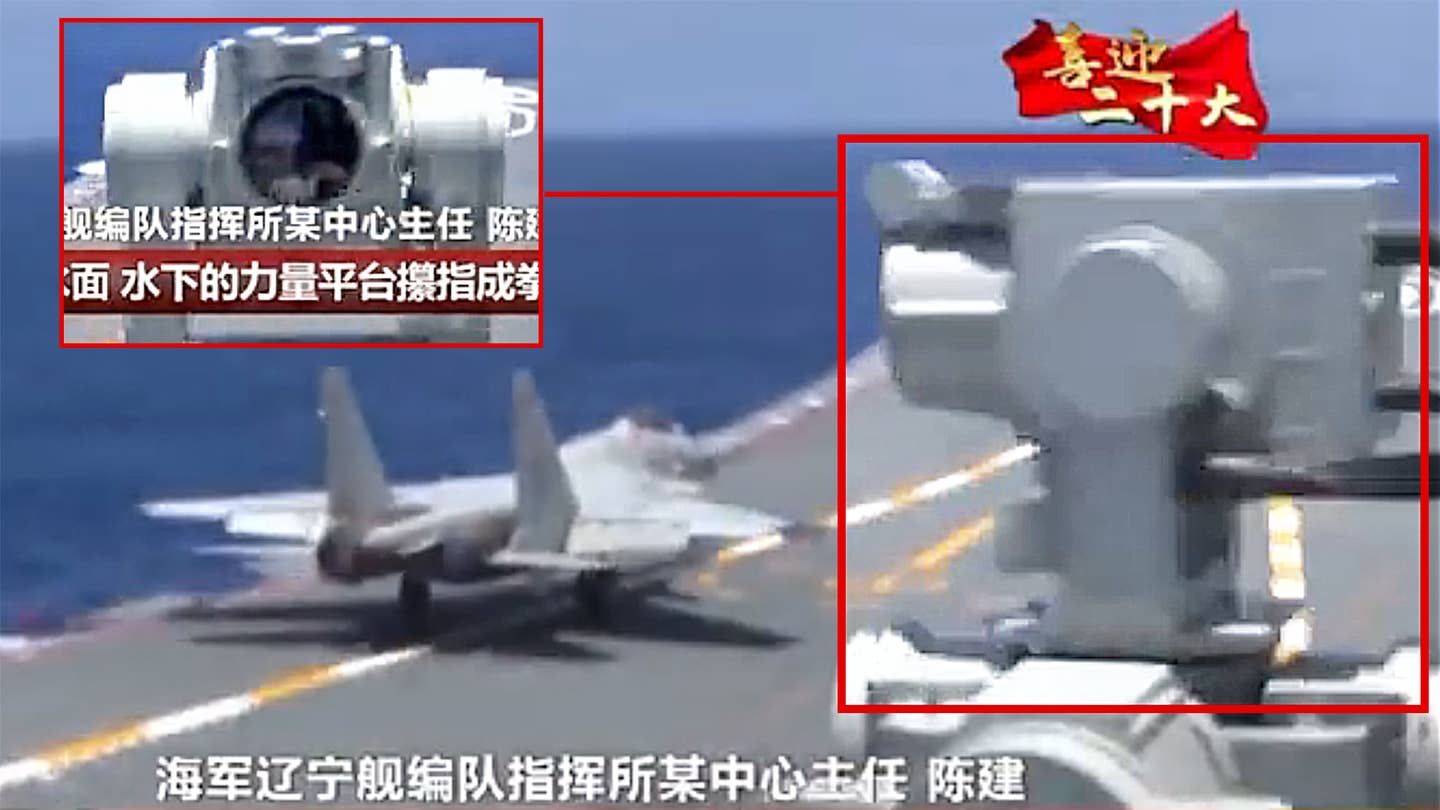The latest video of China’s Type 001 Liaoning aircraft carrier from a Chinese state TV broadcast has revealed an interesting spinning optical device mounted on the ship’s island.
The exact designation of this device is unclear, but it reportedly enhances the carrier’s ability to detect and track potential threats. Based on its appearance and characteristic continuous rotation, the optical device seems to be a panoramic infrared search and track-type system (IRST).
PLA airforces regularly fire live armaments especially BVR missiles something most airforces don’t do relying on captive simulated launches. J-15 assigned to CVN-16 Liaoning Air Wing live firing two PL-12s just before that another J-15 fired trademark unguided rockets. pic.twitter.com/vpKOeXKB3m
— ST (@aviation07101) September 26, 2022
Shortly after the video began circulating on social media, Henri Kenhmann, a defense analyst with the independent French news portal East Pendulum shared a Chinese product card for a system dubbed IR-17, which resembles the rotating optical device seen in the video.
Quelque chose similaire à ceci : pic.twitter.com/tYfrWoAqPh
— East Pendulum (@HenriKenhmann) September 27, 2022
The IR-17 does not exactly look like the device seen onboard the Liaoning, so we have to assume that the optical device seen in the video could be a different or possibly even the production version.
Nevertheless, China’s interest in this capability is not a secret, as has been discussed at a great length by EurAsian Times here and here.
Notably, a China Shipbuilding Industry Corporation (CSIC) watermark can be seen printed across the background of the IR-17’s product card.
IR-17 Functions And Capabilities
The product card lists the systems’ basic functions, including searching for potential threats at “low and super-low” altitudes, providing the command and control (C2) system with target information, and feeding real-time target information to the close-in defense weapons.
According to the card, the operational range of the IR-17 is around eight kilometers for sea-skimming anti-ship missiles, about 19 kilometers for other cruise missiles, and about 29 kilometers for fighter jets. Also, the system can reportedly track and memorize at least 30 targets.

As EurAsian Times has discussed earlier, IRST technology is entirely passive, unlike radars which emit radio waves if used in active mode. This means targets detected and then tracked by IRSTs are not alerted, offering an edge to the system’s users.
Furthermore, being an optical device, an IRST sensor is immune to electronic warfare systems that can disrupt radars and other radio frequency emissions.
However, IRST systems cannot provide precise ranging information of a target because they are passive devices, unlike radars which calculate the range of the target using the radio waves reflected off the target’s surface.

Notably, the product card also states that the IR-17 can transmit the cueing data it has acquired directly to a ship’s combat systems in near-real time, and then other systems, such as radars, can be used to determine the range of the target.
The continuous 360-degree spinning motion of the device offers a ‘panoramic’ or 360-degree ‘picture’ of the operational environment in real-time, which could be coupled with artificial intelligence (AI) or Machine Learning (ML) algorithms to detect, classify automatically, and alert operators to the appearance of objects of interest and feed their data into larger combat systems of the ship.
This would enable close-in defensive systems, telescopic electro-optical and infrared sensors abundant on many warships, to immediately investigate objects of interest detected by the IRST system.
It is also possible to determine the target range using multiple IRST devices mounted on different ships or even spread apart on a huge one, providing triangulated positioning range data on a target.
The New System Could Be Useful Against Swarming Drones, Nearby Boats, Stealth Missiles
Reports suggest that the new IRST system could be handy against swarms of small drones and boats near the ship, as these are very difficult to detect.
Most importantly, the device is even more relevant against anti-ship missile threats that the Chinese aircraft carriers would face during wartime. This is especially true in the case of stealth missiles like the AGM-158C Long Range Anti-Ship Missile (LRASM) and the Naval Strike Missile, as well as the Block V Tactical Tomahawk.
In addition to being a stealthy missile, the LRASM relies on infrared imaging seekers for guidance during the terminal phase of its flight toward the target, which means the missile does not have an active radar seeker, which could give away its presence to the ship it is attacking.
Furthermore, these missiles adopt sea-skimming flight profiles, thereby significantly reducing the effectiveness of the traditional radar systems in detecting them. When they are detected, there is little time left to react.
Therefore, a 360-degree IRST device like the one observed onboard the Liaoning could be indispensable for detecting stealth missiles, as the missiles will unavoidably emit thermal radiation, generating a temperature difference against their cold background for the IRST device to pick up.
- Contact the author at tanmaykadam700@gmail.com
- Follow EurAsian Times on Google News




